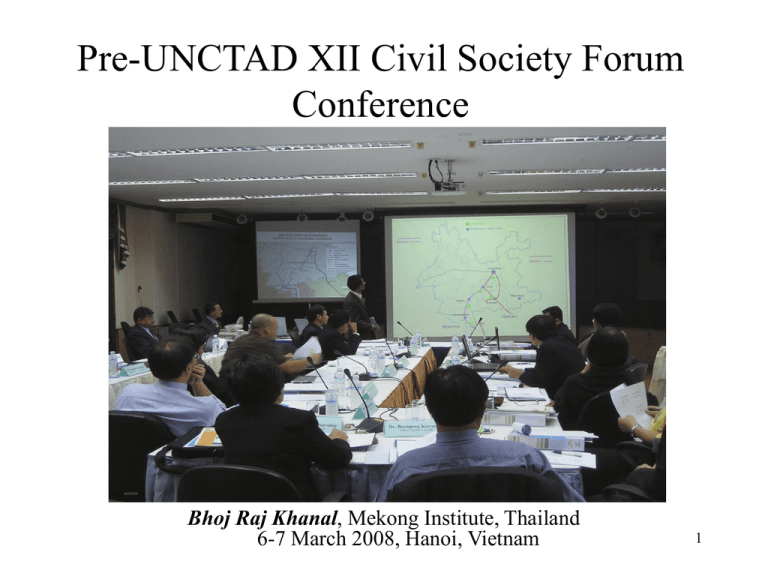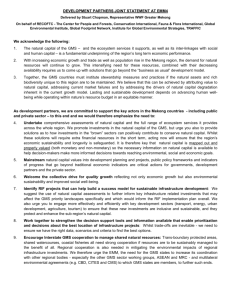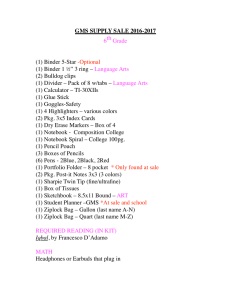Pre-UNCTAD XII Civil Society Forum Conference Bhoj Raj Khanal
advertisement

Pre-UNCTAD XII Civil Society Forum Conference Bhoj Raj Khanal, Mekong Institute, Thailand 6-7 March 2008, Hanoi, Vietnam 1 Theme Harnessing Knowledge for Development to Enhance Productive Capacity, Trade and Investment How can Asian countries harp on global knowledge pool for devising an effective developmental strategy that can bridge the development gaps? What are the perceived systemic failures come in the way of harnessing the positive forces of globalisation? How foreign direct investment could be exploited for facilitating knowledge transfer and productive investment? How to create enabling policy and regulatory frameworks for the development of small and medium-sized enterprises (SMEs) and for attracting FDI? 2 Background of Trade and Development in Asian Countries • With the economic growth of two trade giants India and China and its relation with global trade have been changed. • Economic emergence is facilitated by liberalization trade. The linkages with private agencies have stimulated regional supply networks. • ASEAN economies will emerge as a growth bridge between the giant markets between India and China. 3 Population and Trade (Macro level economies) East Asia leads total economic activities by almost double. South East Asia is intermediate in economic activities. South Asia is low in terms of economic activities. Population Imports East and Central Asia South Asia Population Southeast Asia East and Central Asia South Asia Southeast Asia Trade Source: Zhai, Verbiest, Ronald-host 4 Global Per Capita GDP Growth -1 0 1 2 3 4 5 6 7 8 PRC Sri Lanka Philippines Thailand On a global scenario, Asian continues represent superior growth. Viet Nam Hong Kong, China Malaysia India Korea Bangladesh, India, Malaysia, Philippines, Vietnam will experience per capita income stagnant as of high population growth rate. Indonesia Bangladesh Taipei,China Singapore Australia, NZ United States Latin America Rest of World Europe 17 Japan Real GDP/Cap Source: Zhai, Verbiest, Ronald-host Pop While Japan will sees increment because of shrinking population. 5 • • • • • Discussion Points Asian regional integration and opportunities for Trade Regional trade and integration offer Asia great potential for more rapid and sustained growth. Indeed, much of Asia’s benefits from global trade liberalization can be realized by regional initiative alone. Structural barriers to trade are now more important than tariffs. Policies and investments that facilitate trade can accelerate regional growth dramatically. Regional integration can promote Asian economic convergence, raising average growth rates and benefiting poorer countries. Geographic diversification/new markets (populous countries, better connectivity) 6 GMS Governments Commitments on Road Infrastructures 1992 2006 Source: Asian Development Bank 2015 7 Trade and Development in the GMS Trade Facilitation • Trade facilitation is related to as the “plumbing of international trade” and focuses on the efficient implementation of trade laws, rules and regulations. • In narrow sense, trade facilitation may be defined as the systematic rationalization of procedures and documentation for international trade. • In wider sense, trade facilitation covers all the regulatory measures that affect direct to the flow of imports, exports, transit etc. 8 GMS Economic Corridors 9 Source: Asian Development Bank GMS Border Crossing Points FULL IMPLEMENTATION BY 2009 Source: Asian 10 Development Bank Why Trade Facilitation is Important (GMS perspectives)? GMS Perspective Movement of goods and people Exports from the seven GMS economies (Including two provinces of China) rose from $26.2 billion in 1990 to $153 billion in 2005 - at a compound annual rate of 12.3%, twice as fast as the rise in world exports. Trade openness increased in all regions Share of intra-regional to total GMS trade grew from just over 5% in 1992 to over 12% in 2002, and continues to be on the rise Marked change in commodity structure of exports The GMS proximity with the rapidly growing markets in China and India. Source: ADB Key Indicators of Developing Asian and Pacific Countries 11 Socio-economic Impacts of Rubber Plantation in Lao PDR Luang Nam Tha 12 Some Photos Luang Nam Tha, Lao PDR 13 Focus of GMS Cross Border Transport Agreement • Facilitation of border crossing formalities (single window and single stop customs inspection, coordinating of hours of operation) • Facilitate cross-border movement of people (multi-entry visa, recognition of driver license) • Facilitate cross-border movement of goods (regional transit regime) • Exchange of traffic rights • Set requirements for admittance of road vehicles • Pilots implementation focus on selected GMS border crossings Who will get the most benefits? 14 Who will get the benefits? Few examples • Extensive rubber plantation clearing the natural forests in Lao PDR (displacing minorities along with North south economic corridors and East west economic corridors) • Investors from China, Thailand and Vietnam • 16000 ha of lands (mostly forest land) are cleared and planted in Luang Nam tha province alone • Bio fuel jatropa planting in EWEC (9000 ha in Savanakhet province only) • Issues of biodiversity, foreign investors • Economic corridors initial studies shows that there are replacements of SMEs by international trade • Shrinking the volume of community trade and diverting them in other service sectors 15 Who will get the benefits? Few examples • Infrastructure in the name of trade (specially road networks) has replaced marginalized people who do not have land certificates • If they have it, they are forced to sell their land to elite people (Phitsanulok, Thailand) • It is Indo China junction of Thailand (NSEC and EWEC) and Cambodia (Southern Economic Corridors) • People living these areas have got no compensation, if govt provide it, very less as compared to market price and have to wait years to get so called “compensation” 16 Who will get the benefits? Few examples Contract farming (in the name of trade) • Investors from Thailand have heavily invested in Myanmar (Myawaddy, Myalaymine) and Lao PDR (Savanakhet province) • Should follow all technology (inputs) FDI is increasing in the GMS but what cost? • Seems new economic colonization • Impact on local economy and communities Government perception on Trade in the GMS • Only export to the East Asia, EU and USA • What about internal trade and intra regional trade within the GMS countries to boost local economy 17 Scenario of Regional Growth and Trade: GMS Perspectives • Trade can play a major role in the development of the region. • South East Asia is ahead in openness than other region for regional liberalization and trade facilitation. • More regional cooperation and treaties have been in place in South East Asia (ASEAN FT, ASEAN PRC, GMS CBTA, Bilateral Agreements etc) • Vietnam, Cambodia, Myanmar and Laos (CLMV) can be pillars for Asian Growth so trade giants India and China have more interest on these region. 18 Other positive scenario for Trade Growth in the GMS • • • • • • FDI is increasing Consistent on aid receiving Effective regional cooperation exits Human resources Private sector involvement in development National capital market and potentiality of regional capital market development 19 Challenges: Poverty Reduction and Harnessing Benefits from trade • Administrative reform will be the barrier • Lack of employment based education • Some countries have not established national capital market development • Lack of pro-poor based trade liberalization which could lead the majority of people in marginalized groups • Retention of Human resources • Regional growth rate and living standards remain uneven • Modest progress towards improving regional trade efficiency will have great implication on trade • Lose negotiation and bargaining power • Environmental degradation 20 Challenges: Poverty Reduction and Harnessing Benefits from trade • Increased influence of transnational cooperation will lead to the influence in policy decision and domestic economy • Loss of employment opportunities for locals by replacing technology (harm for labour intensive technology) • Exploitation of marginalized people’s resources and their displacement • Drag small and medium farmers in the vulnerable groups • Threat to SMEs development because of bigger investors • Cause of loss of livelihood, employment and businesses • Inequality in terms of gender (biases) 21 Conclusions 1. Growth prospects for the GMS are quite positive, and trade can play a central role. 2. Regionalism and trade facilitation should be very high priorities for the region. 3. Asian trade can increase in nearly all directions including GMS which is getting one of the highest growth rates. 22 Conclusions 4. ASEAN generally, and the Greater Mekong Subregion in particular, will contribute to Asian regional convergence: – – – because of geographic reason (location) this region can act as a “growth bridge” between South and East Asia, facilitating regional trade GMS includes some of Asia’s lowest income economies, and these are among the most appropriate for infrastructure to promote regional integration. Myanmar, Laos, Cambodia, and Vietnam have become attracting destinations for India, China and other developed Asian Countries. 23 Measures to adopt harnessing the tread benefits from Trade Facilitation and Investment • Institutional development and policy reforms to attract the investment (domestic and FDI) • Cooperation on trade related infrastructure development • Strengthening National Capital Market Development and conceptualizing Regional Capital Market Development • Human resources development especially labour productivity enhancement • Establish a regional mechanism for information sharing among GMS countries 24 Measures to adopt harnessing the tread benefits from Trade Facilitation and Investment • Capacity building programs in the area of risk assessment and management for trade components • Preparation of national action plans that focus on provincial, domestic, regional and global trade facilitation • Give emphasis on micro and meso level economy. • Public, private sector partnership for community development • Conduct regular research on trade and its impacts on local communities 25 Thank you very much! 26


